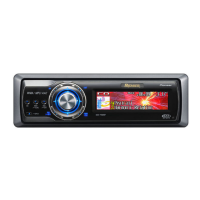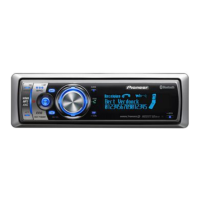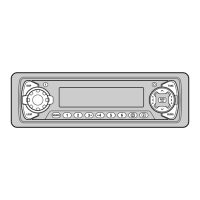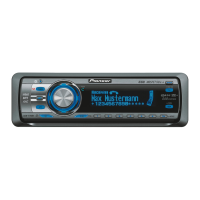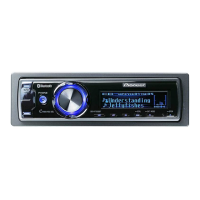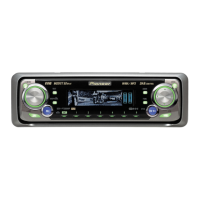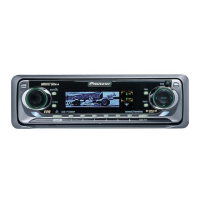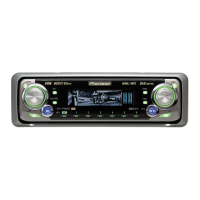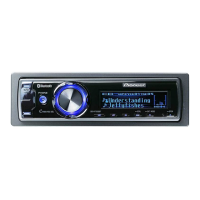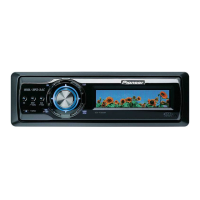
Do you have a question about the Pioneer DEH-P7800MP and is the answer not in the manual?
| CD Playback | Yes |
|---|---|
| CD-R Playback | Yes |
| CD-RW Playback | Yes |
| MP3 Playback | Yes |
| WMA Playback | Yes |
| AAC Playback | Yes |
| Tuner | AM/FM |
| Preset Stations | 24 |
| Preamp Outputs | 3 (Front, Rear, Subwoofer) |
| Display Color | Multi-color |
| Bluetooth | No |
| USB Port | No |
| AUX Input | Yes |
| Detachable Face | Yes |
| High-Pass Filter | Yes |
| Low-Pass Filter | Yes |
| Subwoofer Output | Yes |
| ID3 Tag Display | Yes |
| DIN Size | Single DIN |
| HD Radio | No |
| Power Output | 50 Watts x 4 |
| RMS Power Output | 22 W x 4 Channels |
| EQ Settings | 5-Band |
| Satellite Radio | Ready |
Essential user guidelines, warnings, precautions, unit details, and manual usage instructions.
Details on contacting Pioneer for service, warranty, and product registration procedures.
Information on CD, MP3, WMA, AAC, WAV formats, iPod compatibility, and satellite radio readiness.
Procedures for microprocessor reset, front panel removal, and explanation of demonstration modes.
Instructions for remote battery installation, basic operation, and specific button functions.
Identification and function of buttons and indicators on the main head unit.
Identification and function of all buttons on the remote control.
Instructions for turning the main unit on and off using the SOURCE button, including antenna control.
Guide to selecting various audio sources like Tuner, CD Player, iPod, AUX, etc.
Procedure for inserting and ejecting CDs into the unit's loading slot.
Instructions for adjusting the sound volume using the head unit's MULTI-CONTROL or the remote control.
How to select the tuner source, bands, and perform manual and seek tuning for radio stations.
Overview of advanced tuner functions including menu navigation and station selection modes.
How to store up to six favorite radio frequencies for quick recall using memory functions.
Automatically stores the six strongest broadcast frequencies for easy access.
How to view and select stations from the stored preset channel list.
Adjusting local seek tuning sensitivity to receive only strong radio stations.
Steps for playing a CD, selecting tracks directly, and basic playback controls.
Using repeat, random, and scan modes for enhanced CD playback experience.
Managing custom disc titles and displaying text information from CD TEXT discs.
Selecting tracks from a title list and scrolling text information displayed on the unit.
Basic steps for playing audio files from discs, including folder selection and playback controls.
How to select a specific track by entering its number within the current folder on the disc.
Overview of advanced playback functions for digital audio files.
Setting folder, track, or disc repeat modes for continuous playback of digital audio files.
Enabling random play for tracks within selected repeat ranges (folder or disc).
Listening to the beginning of tracks in a folder or disc to find desired content.
Temporarily stopping and resuming playback of MP3, WMA, AAC, or WAV files.
Switching between fast forward/reverse and searching every 10 tracks for digital audio files.
Roughly searching for tracks by skipping in 10-track intervals within a folder.
Viewing text information such as folder name, file name, artist, and title.
How to scroll long text information that exceeds the display capacity.
Navigating and selecting files or folders using the file name list.
Enabling the display of album artwork for folders on CD-ROM discs.
How the unit automatically reads and displays jacket arts when a disc is inserted.
Navigating the jacket art list to select folders for playback.
Steps for playing a CD with the multi-CD player, including track selection.
How to select a specific track by entering its number using the remote control.
Information on functions supported by 50-disc multi-CD players and their limitations.
Overview of advanced playback functions for multi-CD players.
Setting repeat modes (disc, track, multi-CD) for continuous playback.
Enabling random play for tracks within selected repeat ranges (multi-CD, disc).
Listening to the beginning of tracks or discs to find desired content in the multi-CD player.
Temporarily stopping and resuming playback of the current CD in the multi-CD player.
Creating and playing custom playlists of favorite tracks from the multi-CD player.
Inputting and displaying custom titles for CDs for easier searching and playback.
Accessing and displaying text information encoded on CD TEXT discs with a compatible player.
Navigating and selecting CDs using the entered disc title list.
Steps for selecting and playing songs from an iPod, including basic playback controls.
Navigating iPod music library by category (playlists, artists, albums, songs, genres) for selection.
How to choose specific playlists and songs for playback from your iPod.
Viewing text information like album title, song title, and artist name recorded on the iPod.
Overview of advanced playback functions for iPods, including repeat and shuffle modes.
Setting repeat modes (repeat one song, repeat all songs) for iPod playback.
Enabling Shuffle Songs or Shuffle Albums modes for random playback of iPod content.
Temporarily stopping and resuming playback of the current iPod song.
Basic steps for selecting the XM tuner source and tuning to channels.
Overview of advanced XM tuner functions, including display and channel select modes.
How to store up to six favorite XM stations for quick recall.
Changing the information displayed for XM channels, such as name, artist, and title.
Choosing between selecting XM channels by number or by category.
Navigating and selecting XM channels within specific categories.
How to display the Radio ID code by selecting CH:000 in Channel Number select mode.
Using RADIO ID as a channel category for displaying the ID code.
Viewing and selecting stored XM stations from the preset channel list.
Basic steps for selecting the SIRIUS tuner source and tuning to channels.
Overview of advanced SIRIUS tuner functions, including display and channel select modes.
Changing the information displayed for SIRIUS channels, such as name, category, and artist.
Selecting between continuous or one-time scrolling for text information.
How to store up to six favorite SIRIUS stations for quick recall using preset buttons.
Choosing between selecting SIRIUS channels by number or by category.
Navigating and selecting SIRIUS channels within specific categories.
How to display the Radio ID code by selecting CH:000 in Channel Number select mode.
Basic steps for selecting the TV tuner source and tuning to channels.
Overview of advanced TV tuner functions, including BSSM and station selection.
How to store up to 12 favorite TV stations for quick recall.
Automatically stores the 12 strongest broadcast stations sequentially for easy access.
Viewing and selecting stored TV stations from the preset channel list.
Basic steps for playing discs (DVD, CD, MP3/WMA) with a connected DVD player.
Choosing a specific disc from a connected multi-DVD player.
Navigating and selecting folders for MP3/WMA playback with a connected DVD player.
Overview of advanced playback functions for DVD, Video CD, CD, MP3/WMA.
Setting repeat modes (disc, chapter, title, track, folder) for various disc types.
Temporarily stopping and resuming playback of the current disc.
Enabling random play for tracks during CD/MP3/WMA playback.
Listening to the first 10 seconds of each track to find desired content.
Using ITS playlists and custom disc titles with compatible multi-DVD players.
Step-by-step guide on how to input and save custom titles for CDs in the DVD player.
Simple adjustments for equalizer curves, position, and balance to match car acoustics.
Detailed adjustments for position selector, fader, subwoofer, and filters for precise sound tuning.
Adjusting sound equalization to match car interior acoustics using preset curves.
Advanced audio features including BBE sound, compression, loudness, source levels, and auditory interface.
Customizing various system settings for optimal performance and user preference.
Choosing the preferred language for the unit's display from multiple options.
Setting the unit's internal calendar, including day, month, and year.
Setting the unit's internal clock, including hour and minute adjustments.
Enabling or disabling the warning tone that sounds when the front panel is not detached promptly.
Enabling or disabling the automatic opening and detaching of the front panel for theft protection.
Activating or deactivating auxiliary input sources (AUX1, AUX2) for connected equipment.
Enabling or disabling the automatic dimming of the display when car headlights are turned on.
Adjusting the brightness level of the unit's display.
Switching the digital attenuator to Low to reduce distortion caused by high recording levels.
Managing automatic sound muting or attenuation based on external equipment signals.
Enabling or disabling the automatic feature demonstration mode.
Enabling or disabling the screen indication reversal that occurs after a period of inactivity.
Selecting continuous or one-time scrolling for text information displayed on the unit.
Procedure for measuring and recording vehicle RPMs to ensure proper tachometer function.
Instructions for turning the clock display on or off using the CLOCK button.
Connecting and selecting auxiliary equipment (VCR, portable devices) as audio sources.
Changing the visual display theme and selecting entertainment display modes.
Operating preprogrammed functions for various sources using the PGM button on the remote control.
Updating entertainment display data from a computer via CD-R, including download and rewriting procedures.
List of common error messages, their causes, and recommended actions for the built-in CD player.
List of error messages related to rewriting entertainment displays and their solutions.
Guidelines for maintaining the CD player and information on compatible CD types.
Details on audio compression standards, encoding, and playback compatibility for various file formats.
Information on folder organization, numbering, tier limits, and playback order for digital audio files.
Definitions of technical terms and explanations of audio technologies like AAC, MP3, WMA, WAV, VBR.
Electrical, physical, and dimensional specifications for the unit.
Specifications related to power output, impedance, equalizer, and subwoofer settings.
Technical details for the FM tuner, including frequency range, sensitivity, and signal-to-noise ratio.
Technical details for the AM tuner, including frequency range and usable sensitivity.
